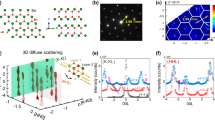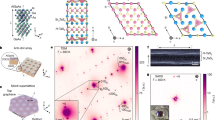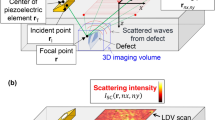Abstract
IN a recent note Preston1 has commented upon the agreement of his experimental results for the diffuse scattering of X-rays by single crystals of aluminium with the predictions of both the Preston–Bragg block hypothesis and a formula derived by Faxén. It seems necessary to correct the impression which might thereby be formed that the Preston–Bragg hypothesis is reconcilable with the Faxén–Waller theory. This is indeed not the case. It has been shown by Laue2 that if the intensity of scattering from a finite crystal is plotted in the reciprocal lattice space as a function of the end-point of the vector (unit vectors in the direction of incident and reflected ray, wave-length) drawn from the origin of the reciprocal lattice, then the resulting distribution of scattering power is periodic with the periods of the reciprocal lattice, so that in particular there is the same distribution about every reciprocal lattice point. On the other hand, the Faxén formula discussed by Preston is obtained by specialization (see below) from a general expression derived by both Faxén3 and Waller4 for the first approximation to the coherent diffuse scattering from a monatomic cubical crystal. This general expression can be written in the form: where are unit (and orthogonal) vectors defining the directions of oscillation of those three acoustical vibrations the wave vector of which satisfies the Faxén-Waller vector condition (namely where is that reciprocal lattice vector the end-point of which lies nearest to that of ) and I1, I2, I3 are the respective frequencies of these vibrations. Owing to the occurrence in this expression of the cosines of the angles between the vector and the vectors of oscillation, it is clear that the expression must lead to a different distribution of scattering power about each point of the reciprocal lattice. In a paper which I have in preparation, the general Faxén-Waller expression has been evaluated for various relative values of the three elastic constants c11, c12, c44 of a cubic crystal, and the marked dependence of the scattering power upon the elastic anisotropy demonstrated. For example, for sodium single crystals, using the values of the elastic constants determined by Quimby and Siegel5, namely, c1 = 0.760 c11, c44 = 0.914 c11 (at 200° K.), with cubic anisotropy c11-c12’2c44 = -1.59 c11, the section of the contours of isodiffusion of the 200 and 110 reflexions in the 200,020 plane of the reciprocal lattice approach, in the limiting case of long elastic waves, that is, proximity to the Bragg spot, the shape shown in the accompanying diagram.
This is a preview of subscription content, access via your institution
Access options
Subscribe to this journal
Receive 51 print issues and online access
$199.00 per year
only $3.90 per issue
Buy this article
- Purchase on SpringerLink
- Instant access to full article PDF
Prices may be subject to local taxes which are calculated during checkout
Similar content being viewed by others
References
Preston, G. D., NATURE, 147, 358 (1941).
v. Laue, M., Ann. Phys., 26, 55 (1936).
Faxén, H., Z. Phys., 17, 266 (1923).
Waller, I., Uppsala Universitets Årsskrift (1925).
Quimby and Siegel, Phys. Rev., 54, 293 (1938).
Laval, J., Bull. Soc. Fr. Minéralogie, 62, 137 (1939)
Author information
Authors and Affiliations
Rights and permissions
About this article
Cite this article
JAHN, H. Diffuse Reflexion of X-Rays. Nature 147, 511 (1941). https://doi.org/10.1038/147511a0
Issue date:
DOI: https://doi.org/10.1038/147511a0



